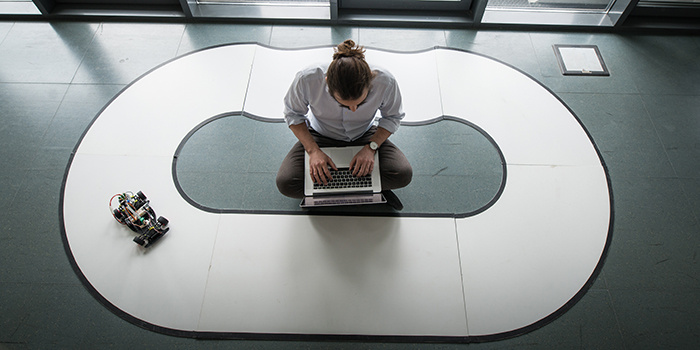Display screen equipment workstations
Definitions - Title VII Legislative Decree 81/08
Display screen equipment operator: a worker who habitually uses display screen equipment for at least 20 hours per week, excluding the breaks envisaged by law.
Display screen equipment: an alphanumeric or graphic display screen, regardless of the display process employed.
Workstation: an assembly comprising display screen equipment, which may be provided with a keyboard or input device, including a mouse, software determining the operator/machine interface, optional accessories, peripherals including the diskette drive, telephone, modem, printer, document holder, work chair and work desk or work surface, and the immediate work environment.
Risks associated with the use of display screen equipment
In assessing these risks, the employer performs an analysis of workstations, particularly as regards:
1. possible risks to the eyes and eyesight:
- Incorrect lighting conditions,
- Incorrect position of the workstation in relation to windows and light sources, resulting in glare, reflections or excessive contrast,
- Uncomfortable microclimate (humidity, temperature, draught),
- Incorrect adjustment of screen software parameters,
- Non-ergonomic workstation,
- Sustained close-up work,
- It is important for workers to take their eyes off the screen every now and then to look at something far away.
2. problems related to posture and physical or mental fatigue:
- Back pain as a consequence of sitting for too long and/or in an incorrect position,
- Muscle pain caused by the reduced blood flow to the muscles when these are held in a static, contracted position,
- Hand and forearm pain due to inflammation of nerves and straining or compression of tendons,
- Workers should change position regularly by standing up straight.
3. environmental ergonomics and hygiene.
The work desk or work surface
- Must be stable,
- Must have a low-reflectance surface,
- Must be large enough to allow a flexible arrangement of the screen, keyboard and related equipment,
- Must be at a height of about 70-80 cm from the floor with sufficient space for the user’s legs and for the chair, including the arm rests, if present,
- Must be deep enough to ensure an adequate distance between the eyes and the screen and enough room for the user’s hands and forearms.
The ergonomic chair
- Must be stable,
- Must have an adjustable seat height,
- Seat dimensions must meet the anthropometric needs of the user,
- Must have a swivel mechanism to facilitate changes of position and make the chair easy to move,
- Must provide adequate support for the user’s back,
- The backrest must be adjustable in height and tilt,
- Both the backrest and the seat must have smooth edges and be made of breathable material that can be cleaned.
Dimensions according to UNI EN 1335 -1
| |
Type A work chair More adjustment options |
Type B work chair Intermediate requirements and dimensions |
Type C work chair Basic requirements and dimensions |
| Minimum seat height |
< 40 cm |
< 42 cm |
|
| Maximum seat height |
> 51 cm |
> 48 cm |
|
| Seat tilt and depth adjustable from a seated position |
required, minimum seat depth adjustment range 50 cm |
not required |
|
| Lumbar support adjustable in height from a seated position (with fixed or mobile backrest) |
required, minimum adjustment range 50 cm |
no requirement specified |
|
| Backrest tilt adjustable from a seated position |
required |
no requirement specified |
|
| Internal distance between arm rests |
minimum 46 cm, maximum 51 cm |
minimum 46 cm |
|
| Minimum backrest width |
≥ 36 cm |
||
| Minimum seat width |
≥ 40 cm |
||
The display screen
- Must have a high-definition image,
- The image must be stable, with no flickering or other forms of instability,
- The screen must swivel and tilt and be adjustable in height,
- The characters on the screen must be clearly formed, of adequate size and with adequate spacing between them,
- The brightness contrast between the characters and the background must be correct and easily adjustable to ambient conditions,
- There must be no reflections or glare,
- The top of the screen at the height of the eyes and perpendicular to the line of vision must be at a distance of between 50 and 70 cm.
Keyboard and mouse
- The keyboard must be separate from the screen and easily adjustable,
- It must be tiltable,
- It must have a matt surface to avoid reflective glare,
- The symbols on the keys must be adequately contrasted and legible,
- The mouse and other pointer devices must be arranged on the same surface as the keyboard, in a position where they can easily be reached and there is adequate room to enable their use.
Portable display screen equipment
Notebook workstations must also be set up properly, adjusting the work chair, positioning and adjusting the screen, paying particular attention to the position of windows or other light sources that could cause undesirable reflections or glare.
Notebook devices used on a continuous basis must be used with a separate keyboard and mouse.

Workers’ control for use display screen equipment
Before being assigned to use display screen equipment, workers must:
- Undergo a medical examination by the company occupational physician and, if necessary, by an ophthalmologist,
- Subsequent check-ups are mandatory and must be performed every two years for workers found to be “fit for the job subject to conditions or limitations” and for those aged 50 and over, and every five years for all other workers,
- Workers may ask to have a check-up at any time if they notice any problems with their eyesight that might be linked to the use of display screen equipment.
